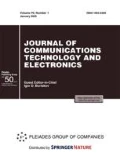Abstract
In the paper, a new approach to identifying zones with rare anomalous manifestations of geological processes is proposed. The approach is based on two one-class classification methods of machine learning: the method of minimum area of alarm and the method of preference. The algorithm of minimum area of alarm is nonparametric. It is trained on a sample of anomalous events and computes the field of anomalous zones. The knowledge obtained by this method is non-verbalized. The method of preference allows approximating the obtained solution by a rather simple logical rule that defines the anomalous region in terms of analyzed properties of the geological environment. Examples of this approach to finding areas of possible foci of strong earthquakes and to make a regional forecast of deposits are considered.









Similar content being viewed by others
REFERENCES
V. Schenk, Z. Schenkova, and V. G. Gitis, “Features of geonomic prognostic functions for the maximum possible earthquake,” Natural Hazards 10 (1–2), 97–15 (1994).
V. G. Gitis and B. V. Ermakov, Bases of Space-Time Forecasting in Geoinformatics (Fizmatlit, Moscow, 2004) [in Russian].
C. M. Bishop, Machine Learning and Pattern Recognition. Information Science and Statistics (Springer, Heidelberg, 2006).
S. B. Kotsiantis, I. Zaharakis, and P. Pintelas, “Supervised machine learning: A review of classification techniques,” Emerging Art. Intell. Appl. Comput. Eng. 160, 3–24 (2007).
S. S. Khan and M. G. Madden, A Survey of Recent Trends in One Class Classification. Irish Conference on Artificial Intelligence and Cognitive Science (Springer, Heidelberg, 2009).
V. G. Gitis and A. B. Derendyaev, “Machine learning methods for seismic hazards forecast,” Geosciences 9, 308 (2019).
V. G. Gitis, Bases of the Geoinformation Forecast of Minerals and Analysis of Geological Processes (VINITI, Moscow, 2012).
A. P. Bradley, “The use of the area under the ROC curve in the evaluation of machine learning algorithms,” Pattern Recogn. 30, 1145–1159 (1997).
A. D. Zakrevskii, “Optimization of coverings of sets,” in Logical Language for Representation of Synthesis Algorithms of Relay Devices (Nauka, Moscow, 1966), pp. 136–147.
P. W. Burton, “Seismic risk in southern Europe through to India examined using Gumbel’s third distribution of extreme values,” Geophysical J. Int. 59, 249–280 (1979).
A. Kijko, “Estimation of the maximum earthquake magnitude, m max,” Pure Appl. Geophys. 161, 1655–1681 (2004).
I. M. Gelfand, S. A. Guberman, V. I. Keilis-Borok, L. Knopoff, F. Press, E. Y. Ranzman, I. M. Rotwain, and A. M. Sadovsky, “Pattern recognition applied to earthquake epicenters in California,” Phys. Earth Planetary Interiors 11, 227 ̶ 283 (1976).
V. I. Bune and G. P. Gorshkov (Ed.), Seismic Division into Districts of the Territory of the USSR: Methodical Bases and Regional Description of the Card of 1978 (Nauka, Moscow, 1980).
H. Philip, A. Cisternas, A. Gvishiani, and A. Gorshkov, “The Caucasus: an actual example of the initial stages of continental collision,” Tectonophysics 161 (1–2), 1–21 (1989).
R. H. Sibson, “Frictional constraints on thrust, wrench and normal faults,” Nature 249 (5457), 542–544 (1974).
V. G. Gitis, B. V. Ermakov, L. V. Ivanovskaya, B. V. Osher, D. P. Trofimov, and Yu. K. Shchukin, “The GEO Expert System: Application for seismic hazard analysis of the caucasus region,” in Cahiers du Centre Europeen de Geodynamique et de Seismologie (Centre Europeen de geodynamique et de seismologie, 1992), pp. 136–147.
N. V. Kondorskaia and N. V. Shebalin, “New Catalog of trong earthquakes in the USSR from ancient times throug 1977,” World Data Center A for Solid Earth Geophys. 31 (1982).
Earthquakes in the USSR in 1975–1988 (Nauka, Moscow, 1990).
V. G. Gitis, T. V. Dobrev, B. V. Ermakov, N. Yu. Kubareva, and Yu. K. Shchukin, “Application of the GEO expert system for the regional forecast of zinc-lead fields of Bulgaria,” Geofiz. J. 11 (4), 36–48 (1989).
F. N. Wolfson and N. M. Druzhinin, The Main Types of Ore Fields (Nedra, Moscow, 1975).
T. N. Shaldun and M. G. Dobrovolskaya, “Ore formations of zinc-lead fields,” in Ore Formations of Endogenous Fields (Nauka, Moscow, 1976), pp. 149–297.
B. Bogdanov, D. Dimitrov, M. Staikov, et al., Ore Formations of Karpato-Balkansky Area (Nedra, Moscow, 1978).
Yu. A. Kosygin and E. A. Kulish, Main Types of Ore Formations. Terminological Reference Book (Nedra, Moscow, 1978).
Funding
The study was accomplished at the Institute for Information Transmission Problems, Russian Academy of Sciences, and partially supported by the Russian Foundation for Basic Research, project no. 20-07-00445.
Author information
Authors and Affiliations
Corresponding author
Additional information
Translated by N. Semenova
Rights and permissions
About this article
Cite this article
Gitis, V.G., Derendyaev, A.B. & Petrov, K.N. A Method for Identification of Anomalous Geological Zones. J. Commun. Technol. Electron. 65, 1531–1541 (2020). https://doi.org/10.1134/S1064226920120074
Received:
Revised:
Accepted:
Published:
Issue Date:
DOI: https://doi.org/10.1134/S1064226920120074




